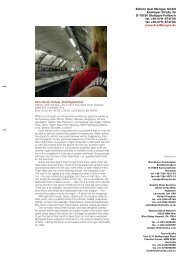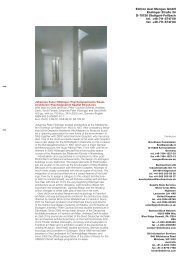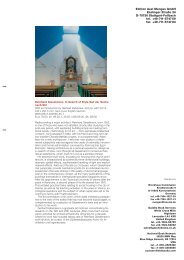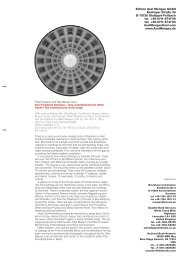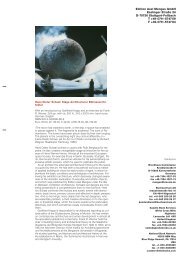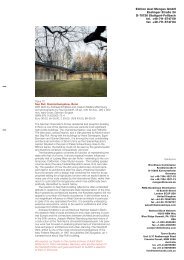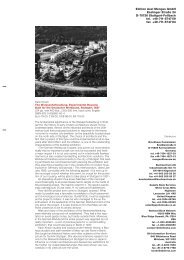Learning from Hollywood - Edition Axel Menges
Learning from Hollywood - Edition Axel Menges
Learning from Hollywood - Edition Axel Menges
Sie wollen auch ein ePaper? Erhöhen Sie die Reichweite Ihrer Titel.
YUMPU macht aus Druck-PDFs automatisch weboptimierte ePaper, die Google liebt.
<strong>Hollywood</strong> ist nicht nur die geheime Welthauptstadt<br />
der Träume, der Fiktionen des Unterbewußtseins,<br />
sondern auch die der Architektur.<br />
<strong>Hollywood</strong> ist das Rom und das Versailles des<br />
20. und des 21. Jahrhunderts. Hier wurde ein neues<br />
weltumspannendes Raumbewußtsein geschaffen.<br />
Im Kopf jedes Zuschauers haben sich diese Hintergründe,<br />
Bühnenbilder und Filmräume unauslöschlich<br />
festgesetzt. Im Kino hat man vielleicht zum ersten<br />
Mal die Wüste gesehen, die Felsen der Rocky<br />
Mountains, die Gletscherberge Grönlands und die<br />
Sandstrände Kaliforniens. Man sah hier die Western<br />
Saloons und die dunklen Räume Al Capones, die<br />
Hütten der armen Mexikaner und die Penthouse-<br />
Wohnungen der Kennedys; man sah hier auch die<br />
Jazz-Clubs in New Orleans und die Traumhäuser in<br />
Los Angeles. Es gab und gibt kaum einen Raumwinkel<br />
auf der Erde, in den sich der <strong>Hollywood</strong>-Film<br />
nicht hineingeträumt hätte. Jeder Kinobesucher der<br />
Welt sieht dieselbe Handlung, dieselben Bilder, dieselben<br />
Gesichter, dieselben Räume, Häuser, Städte<br />
und Straßen. Die völkerverbindende Kraft des Films<br />
ist kaum zu überschätzen. Filmarchitektur ist Weltarchitektur.<br />
Alle andere Architektur – die eigene Stadt,<br />
die eigene Straße, das eigene Haus, die eigene<br />
Wohnung – bleibt dagegen klein, regional und in<br />
ihrer Wirkung auf ein winziges Umfeld beschränkt.<br />
Im Spannungsfeld dieser beiden Aspekte – kleinregional<br />
und groß-weltumspannend – wird sich die<br />
künftige Architektur weiterentwickeln. Unter Miteinbeziehung<br />
der Filmarchitekturen könnte die reale<br />
Architektur der Häuser und Städte in ihrer Sprache<br />
bereichert und unter Miteinbeziehung der Studiowelt<br />
die reale Architektur aus ihrer Banalität herausgekippt<br />
werden.<br />
Aus Filmen und Filmbildern kann man lernen,<br />
daß die Architektur der Häuser, Straßen und Städte<br />
nicht nur ein Problem der Ordnung, der Funktion<br />
und der Wirtschaftlichkeit ist, sondern daß hier Psychologie,<br />
Atmosphäre und Bilder mitgebaut werden.<br />
Hans Dieter Schaal lebt als Architekt, Landschaftsgestalter,<br />
Bühnenbildner und Ausstellungsgestalter<br />
in Attenweiler bei Ulm. Seine Bühnenentwürfe<br />
und Ausstellungsgestaltungen gehören zum<br />
Besten, was auf diesem Gebiet zur Zeit geboten<br />
wird.<br />
039.90 Euro<br />
059.00 sfr<br />
036.00 £<br />
049.90 US $<br />
086.00 $A<br />
ISBN 978-3-936681-34-5<br />
9 783936 681345<br />
54990<br />
Hans Dieter Schaal <strong>Learning</strong> <strong>from</strong> <strong>Hollywood</strong> <strong>Menges</strong><br />
Hans Dieter Schaal<br />
<strong>Learning</strong> <strong>from</strong> <strong>Hollywood</strong><br />
Architecture and Film<br />
Architektur und Film<br />
<strong>Hollywood</strong> is not only the secret world capital of<br />
dreams and the fictions of the subconscious, but<br />
also the capital of architecture.<br />
<strong>Hollywood</strong> is the Rome and the Versailles of the<br />
20th and 21st centuries. A new awareness of space<br />
spanning the entire world was created here. These<br />
backgrounds, stage sets and filmic spaces are indelibly<br />
fixed in every spectator’s mind. It may be in<br />
the cinema that the first time you saw the desert,<br />
the Rocky Mountain cliffs, Greenland’s glacier mountains<br />
and California’s sandy beaches. You saw here<br />
the Western saloons and Al Capone’s dark rooms,<br />
the poor Mexicans’ huts and the Kennedys’ penthouse<br />
apartments; you saw here also the jazz clubs<br />
of New Orleans and the dream houses in Los Angeles.<br />
There was and is scarcely a corner of the<br />
earth that the <strong>Hollywood</strong> film has not dreamed its<br />
way into. Every cinema-goer in the world sees the<br />
same plot, the same images, the same faces, the<br />
same rooms, buildings, towns and streets. Film’s<br />
power to bring people together can scarcely be<br />
overestimated. Film architecture is world architecture.<br />
All other architecture – your own town, your<br />
own street, your own house, your own flat – remains<br />
small and parochial in the face of this, restricted to<br />
affecting a very tiny sphere.<br />
The architecture of the future will develop in the<br />
field of tension between these two aspects – small<br />
and parochial, large and spanning the entire world.<br />
The real architecture of houses and cities could be<br />
enriched in its language by including film architecture,<br />
and real architecture could be jolted out of its<br />
banality by including the studio world.<br />
Films and their images can teach us that the architecture<br />
of houses, streets and towns is not just<br />
a problem of order, function and economic viability,<br />
but that psychology, atmosphere and images are<br />
being built here as well.<br />
Hans Dieter Schaal is a trained architect living<br />
in Attenweiler near Ulm. He works as a designer of<br />
buildings, gardens, stage sets and exhibitions. His<br />
stage sets and exhibition designs are among the<br />
best of their kind at present.




